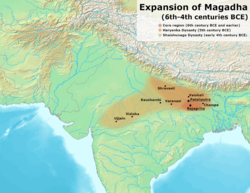Haryanka dynasty
| Haryanka dynasty | ||||||||||||
|
||||||||||||
|
The approximate extent of the Haryanka dynasty between the 6th and 5th century BCE.
|
||||||||||||
| Capital | Rajagriha, later Pataliputra | |||||||||||
| Languages |
Sanskrit Magadhi Prakrit Other Prakrits |
|||||||||||
| Religion |
Hinduism (Brahmanism) Buddhism Jainism |
|||||||||||
| Government | Monarchy | |||||||||||
| King | ||||||||||||
| • | 544-492 BCE | Bimbisara | ||||||||||
| • | 492-460 BCE | Ajatashatru | ||||||||||
| • | 460-440 BCE | Udayin | ||||||||||
| Anuruddha | ||||||||||||
| Munda | ||||||||||||
| • | 437-413 BCE | Nāgadāsaka | ||||||||||
| History | ||||||||||||
| • | Established | Middle of 6th century BCE | ||||||||||
| • | Disestablished | 413 BCE | ||||||||||
|
||||||||||||
| Today part of |
|
|||||||||||
The Haryanka dynasty was the second ruling dynasty of Magadha, an ancient kingdom in India, which succeeded the Barhadratha dynasty. The reign of this dynasty probably began in the middle of 6th century BCE. Initially, the capital was Rajagriha. Later, it was shifted to Pataliputra, near the present day Patna in India.
The founder of this dynasty was either Bimbisara himself or his father Bhattiya. According to the Buddhist text, the Mahavamsa, Bimbisara was anointed king by his father at the age of fifteen. According to George Turnour and N.L. Dey, the name of the father of Bimbisara was Bhatiya or Bhattiya, but the Puranas refer him as Hemajit, Kshemajit, Kshetroja or Ksetrauja and the Tibetan texts mention him as Mahapadma. This dynasty was succeeded by the Shishunaga dynasty.
The Haryanka king Bimbisara was responsible for expanding the boundaries of his kingdom through matrimonial alliances and conquest. The land of Kosala fell to Magadha in this way. He is referred to as King Shrenik in Jain scriptures.
Estimates place the territory ruled by this early dynasty at 300 leagues in diameter, and encompassing 80,000 small settlements.
In some sources, Bimbisara was imprisoned and killed by his son and successor, Ajatashatru, under whose rule the dynasty reached its largest extent. Ajatashatru was contemporary with Mahavira (599–527BCE) and Gautama Buddha (563–483 BCE). Ajatashatru fought a war against Vajji, ruled by the Lichhavis, and conquered the republic of Vaisali. Ajatashatru followed policies of conquest and expansion. He defeated his neighbors including the king of Kosala; his brothers, when at odds with him, went to Kashi, which had been given to Bimbisara as dowry. This led to a war between Magadha and Kosala. Ajatashatru occupied Kashi and captured the smaller kingdoms. Magadha under Ajatashatru became the most powerful kingdom in North India.
...
Wikipedia

